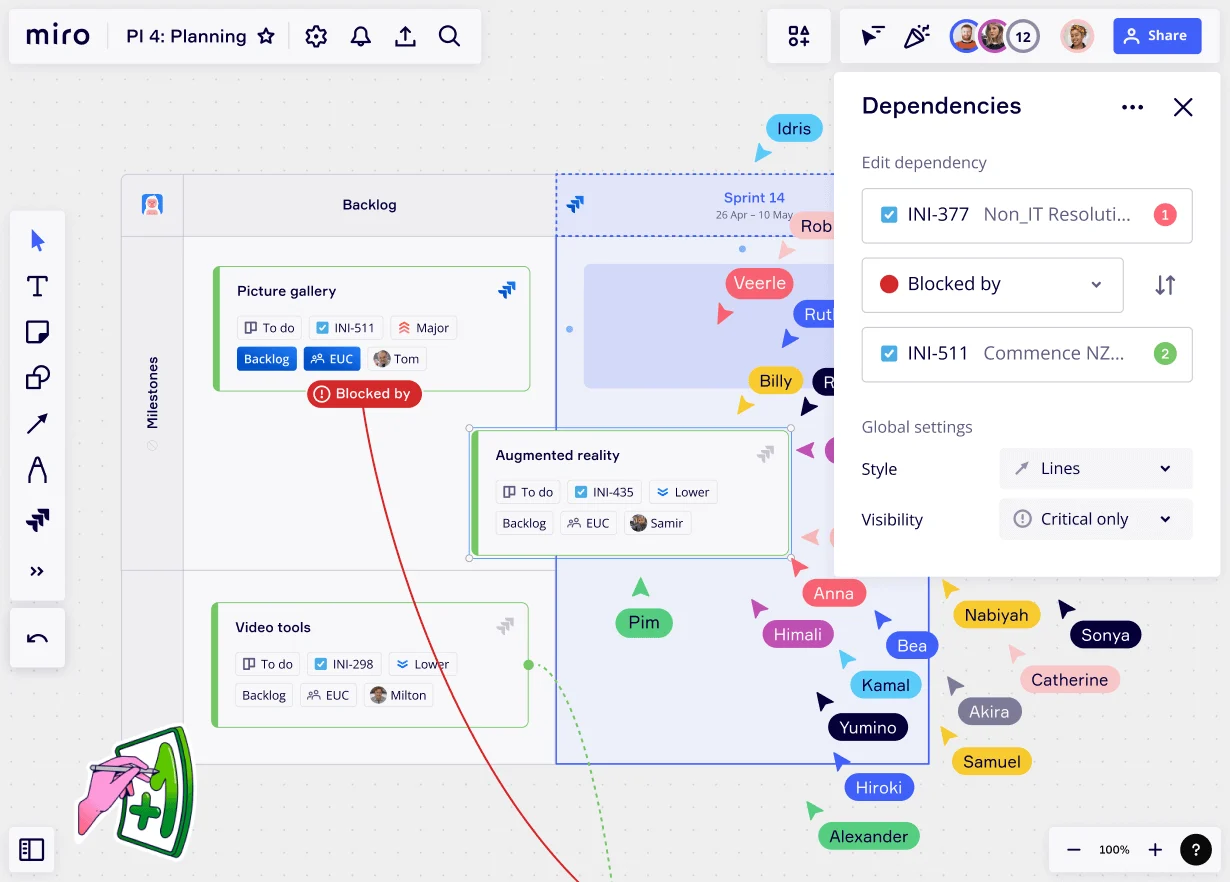
Table of contents
Table of contents
Waterfall vs Agile Methodology

Summary
In this guide, you will learn:
- The fundamental difference between Waterfall (rigid, sequential) and Agile (flexible, iterative) methodologies.
- How Agile emphasizes continuous collaboration, adaptability, and incremental delivery.
- Waterfall’s strength lies in its structured approach with clear documentation and defined roles.
- The pros and cons of each: Agile offers flexibility but can have scope creep; Waterfall offers predictability but lacks flexibility.
- Typical project scenarios for choosing each method: Agile for dynamic projects, Waterfall for simpler, well-defined ones.
- Key challenges and best practices in managing Agile and Waterfall projects, including communication, risk management, and stakeholder engagement.
Try Miro now
Join thousands of teams using Miro to do their best work yet.
In the dynamic domain of software development, the discussion about whether to follow one methodology over another is ever-present. Two methodologies that frequently find themselves at the center of such debates are Waterfall and Agile. Each holds its distinctive merits, and their applicability depends largely on the nature of the project and the organizational setup.
Key differences between Waterfall and Agile
The Waterfall model is suggestive of its modus operandi: it follows a linear and sequential trajectory where projects flow systematically from one stage to another – ranging from initial requirements gathering, to design, implementation, verification, and finally, maintenance. It’s a step-by-step process where one stage needs to be fully completed before embarking on the next.
In contrast, Agile adopts an iterative approach. Instead of one prolonged development cycle, the project is divided into smaller, more digestible units known as sprints. At the end of each sprint, a potentially shippable product increment is presented, which means the project witnesses several development cycles and refinements throughout its duration.
Flexibility and change management
Change management in the Waterfall model can be rather stringent. Once you progress from one stage, revisiting or revising it can disrupt the entire workflow, rendering the Waterfall model somewhat inflexible especially if there's a change in requirements post commencement.
Agile, on the other hand, is crafted to embrace changes. It thrives on regular feedback and adjustments. If new requirements or alterations emerge, they can be seamlessly integrated into the upcoming sprints, making Agile especially suitable for projects where the goalposts might shift.
Stakeholder needs and involvement
In the Waterfall method, stakeholder involvement and feedback loops are largely confined to the bookends of the project. Stakeholders play pivotal roles at the initiation (during requirements gathering) and at the culmination (once the product is ready for delivery).
Agile disperses this involvement throughout the project's lifecycle. After every sprint, stakeholders — which often include clients, and users — provide feedback, and necessary course corrections are made. This recurrent engagement ensures that the final product is intricately tailored to user needs and expectations.
Time to market and product release
Time is of the essence in the software development world. With the Waterfall method, the time to market tends to be elongated since the project has to meander through all its stages before reaching its completion. It’s only after the entire process is wrapped up that the final product sees the light of day. Agile, due to its iterative nature, allows for an early release of a basic version of the product. As the project progresses, subsequent releases offer enhanced and refined versions of the product.
Choosing between Waterfall and Agile
The decision between Waterfall and Agile isn’t one-size-fits-all and hinges on various factors. If you’re dealing with a short and well-defined project, Waterfall might be your best bet. However, Agile shows its prowess in handling both straightforward and intricate projects, particularly when the requirements aren't set in stone from the outset.
The level of stakeholder involvement is another determinant. Projects that demand ongoing feedback and continuous stakeholder engagement are right up Agile's alley. In situations where the requirements are set and unlikely to oscillate, Waterfall might hold the edge.
It boils down to what you prioritize more: predictability and structure (Waterfall) or adaptability and flexibility (Agile).
Hybrid approach between the two
While the Waterfall and Agile methods are distinct in their philosophies, aspects of their tenants can be combined to create a customized fit for certain projects. Enter hybrid methodologies, like the "Water-Scrum-Fall". This approach borrows the structured planning and high-level design facets of Waterfall and marries them with Agile’s prowess in managing the development and implementation stages. The aim is simple: to combine the robustness of both methodologies and offer a blend of structure and adaptability.
In the grand scheme of things, both Waterfall and Agile are potent strategies in the software development arsenal. Which one to use should depend on the nature of the project, the needs of stakeholders, and the specific challenges foreseen. And sometimes, a mix of the two can prove to be the optimal solution.
Author: Miro Team
Last update: October 2, 2025